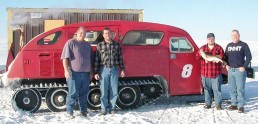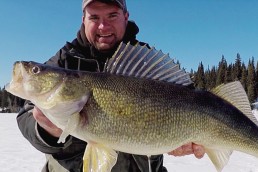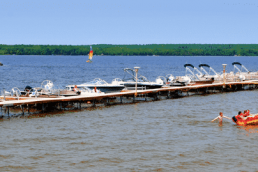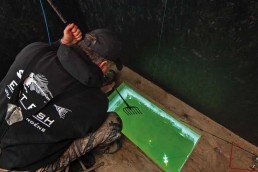The Transformation of Hardcore Ice Transportation
Did you know there is a place that gets super cold in the winter and as the temperature drops, people absolutely flock to it? It’s true. In fact, ice fishing at Lake of the Woods actually draws more people than summer fishing. It never used to be that way. Over the years, generations of resort owners and key personnel have worked on building a better ice-fishing experience. A big part of this experience is the ice rig, track rig, people hauler, call it what you will. The bottom line: The progression to where we are today did not happen overnight and it wasn’t always easy.
“I can remember my Dad talking about pulling the sleigh out on the ice with horses,” explains Ed Arnesen of Arnesen’s Rocky Point. “This was back in the 1930s. During a blizzard one time, he didn’t know which way to go so the horses found the way home.”
Horsepower took on a new meaning when it came to wind sleds.
“A wind sled had an enclosed cab with skis and was actually powered by an airplane motor and propeller. They actually worked pretty well. In the 1960s, we converted a Ford tractor. We put skis on the front and tracks back where the big tires were.
“In about 1988 we started using Steiger tracks. Basically, you can mount them to a variety of vehicles and fit them to vans so we could haul more people. Around 1990 we added the Bombardier to our fleet of vehicles. It had been around a while and really was simple to get and use at that time. Like many of the resorts, we have added Geo Trackers to our fleet as a light ice rig or when there isn’t as much snow. We pull our ‘people hauler’ trailers when it is appropriate.”
Each resort has its own story to tell.
“We used to strip down old jeeps. No doors or roof on it. For a trailer, we used an aluminum boat. We would bend rebar in the shape of a ‘U’ and put each end in the oar holes of the boat. That allowed us to use a big blue tarp to cut the wind for the customers. Underneath the boat, we used two big skids. If you were pulling it too fast or you came down a bank on the lake too quick, the boat might slide by you. It was something else,” explains Gregg Hennum, owner of Sportsman’s Lodge. “Now we use Geo Trackers with beautiful enclosed trailers with RV heaters that blow air, LED lights, big windows and special suspension. We have skis that will strap onto the tires when the snow gets deep. Things have definitely changed.”
Why use Geo Trackers?
“They are not very expensive, they are light and they are durable. They actually have held up well in these tough conditions,” explains Hennum.
“In addition to bombers, we started shifting to SUVs with conversion tracks that go over the tires. They work in some instances, but we are starting to gravitate back towards the bombardiers. The footprint of the track on the conversions is small and doesn’t go over cracks as easy as the long skis and long track of the bombers. Also, the weight isn’t distributed as evenly. It is also handy that the bomber has skis, thus we can use them on the snowmobile trails as long as we have a trail sticker and proper licensing.”
Interestingly enough, one vehicle that has done a nice job withstanding the test of time is the Bombardier. Joseph-Armand Bombardier was a mechanic who dreamed of building a vehicle that could “float on snow.” In 1937, he designed and produced his first snowmobile in his small repair shop in Valcourt, Quebec. This “snowmobile” was actually more of a “snow bus” like the bombardiers operating around Lake of the Woods today.
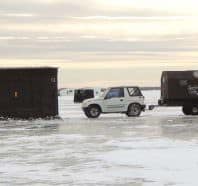
The first Bombardiers or “snowmobiles” as they were called were large, multi-passenger vehicles designed to help people get around during the long winter months. Bombardiers were used in rural Quebec to take children to school, carry freight, deliver mail and as ambulances. His invention filled a very particular need in the region and soon business was booming. In 1941, Armand opened a new factory in Valcourt.
Then a major setback hit the growing business with the start of World War II. The Canadian government issued wartime rationing regulations. Bombardier customers had to prove that snowmobiles were essential to their livelihood in order to buy one. To keep his business going, Armand shifted his focus and developed vehicles for the military. After the war, Bombardier experienced another setback in his snowmobile business. In 1948, the Quebec government passed a law requiring all highways and local roads to be cleared of snow; the Bombardier Company’s sales fell by nearly half in one year.
The company diversified by creating tracked vehicles to clear sidewalks instead of horse-drawn carriages and then by making all-terrain vehicles for mining and forestry.
In 1951, the traditional wooden bodies were replaced by sheet steel and Chrysler flathead 6-cylinder motors with three-speed manual transmissions added. In the 1960s, V8 engines started to appear and in the 1970s, larger, rectangular windows replaced the round port-style windows. The next big change was to the reliable Chrysler industrial 318 engines with automatic Loadflite transmissions. Production of the Bombardier as we know it stopped in the mid-1970s.
With production of Bombardiers stopped, finding them and parts can be challenging.
“The market for Bombers has gone crazy,” explains Gary Moeller of Ballard’s Resort. “We had to go to Quebec to find our last one and it still needed a lot of service work to make it tough enough to withstand the conditions on Lake of the Woods. They have almost become kind of a collector’s item.”
Moeller also talked about how things have really changed.
“We are actually grooming trails on the lake for our Bombers. We use a groomer just like is used on a snowmobile trail. We found that this creates a smoother trail and ride for the customers and adds to less wear and tear on our rigs.”
Moeller says some of the resorts, including Ballard’s, have actually “stretched” the Bombardier making it longer to hold more people.
“There is less weight per cubic inch and it holds 12 people instead of just 8.”
He also mentioned some ideas that worked in one area and not in another.
“We had a hovercraft for about a year. It wasn’t good in storms. It was only good on smooth ice and didn’t stop well. The customers really liked it though.”
Mike Kinsella of Border View Lodge also has seen ideas come and go.
“For a while we had a Haaglund. It was a Swedish-built military vehicle. It had two cars that were connected with four different tracks all with power. It was too slow and didn’t have very good traction in the snow. ”
Border View also tried a Rolligon. This is a truck with monster-sized tires that were developed for travel for oil companies up on the tundra of Alaska. The tires are so big, there is no footprint left on the tundra. “The Rolligon’s didn’t end up working well in our environment either,” Kinsella explained. “The tires didn’t get much traction in snow and on ice and they were too slow. We thought about grooming a trail like we do now for Bombers, but the trail would have had to have been 3 times as wide to fit the tires. It just wasn’t a good fit.
“We have gravitated to being versatile. Different ice and snow conditions demand a variety of equipment. In addition, we have decided to also plow a road for people who prefer to drive their own vehicles out to our fish houses. Every resort has unique circumstances based on where they fish on the lake and the type of customers they are catering to.”
The progressions of ice rigs and “people haulers” have come a long way on the “Walleye Capital.” The next time you are in the warm lobby of a resort with a nice, hot cup of coffee in your hand while waiting for your heated ice chariot to haul you out to the promised land of walleye fishing, be careful not to take for granted the history why this chariot was chosen just for you.
MWO
SHARE THIS POST
Did you enjoy this post?
You can be among the first to get the latest info on where to go, what to use and how to use it!
Joe Henry
Tournament angler and licensed charter captain Joe Henry fishes and hunts the Midwest. Henry is a media member of AGLOW and writes for numerous publications, creates videos, appears on a variety of outdoor TV and radio shows and is a frequent seminar speaker. Henry is the Executive Director of Lake of the Woods Tourism.
